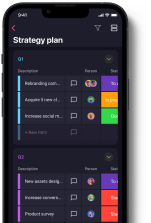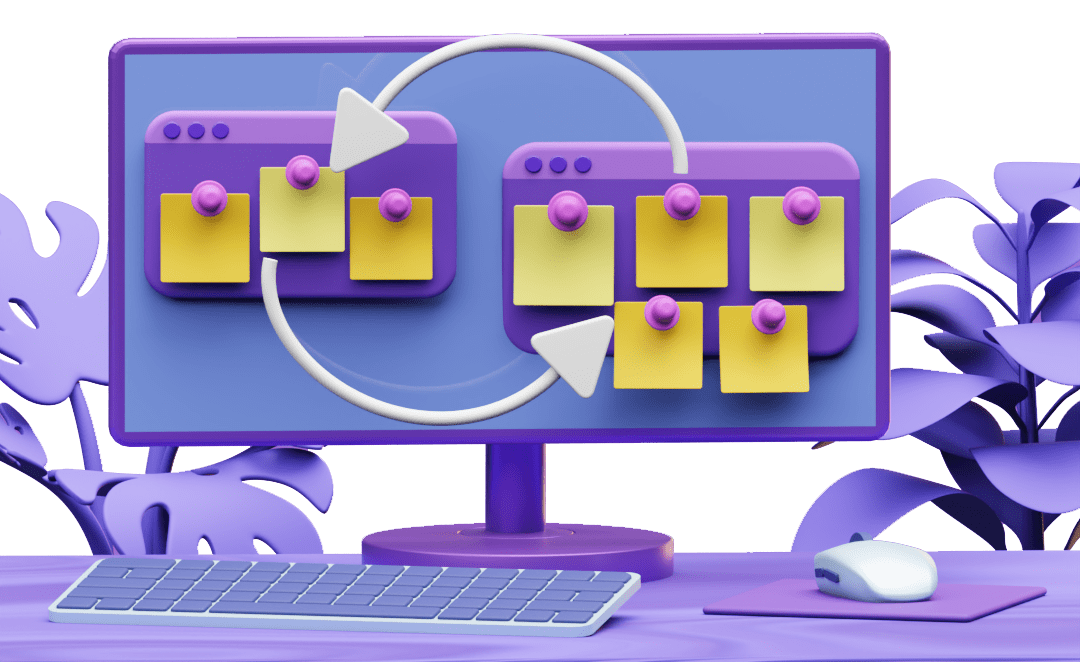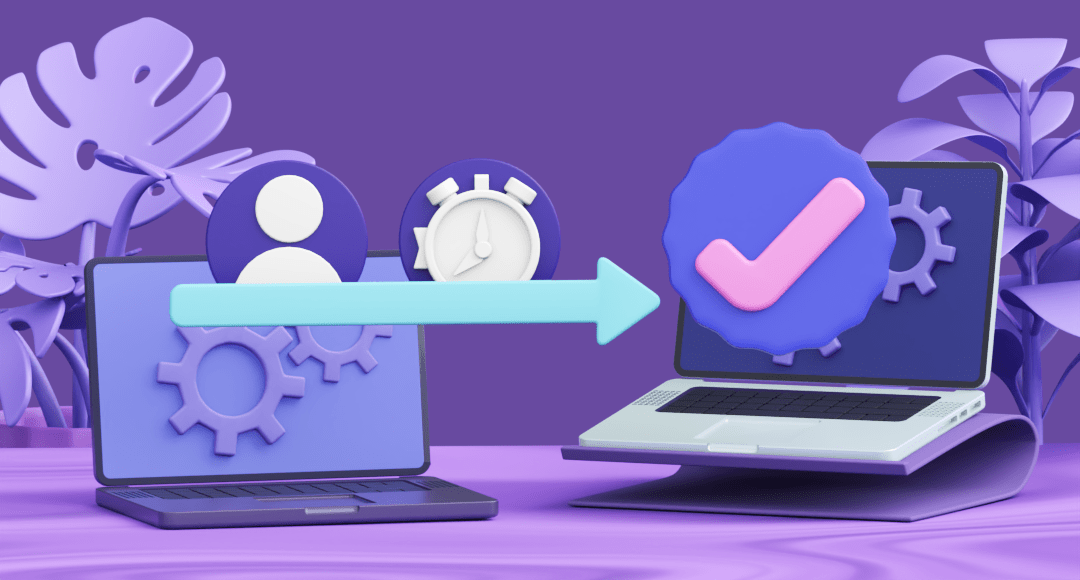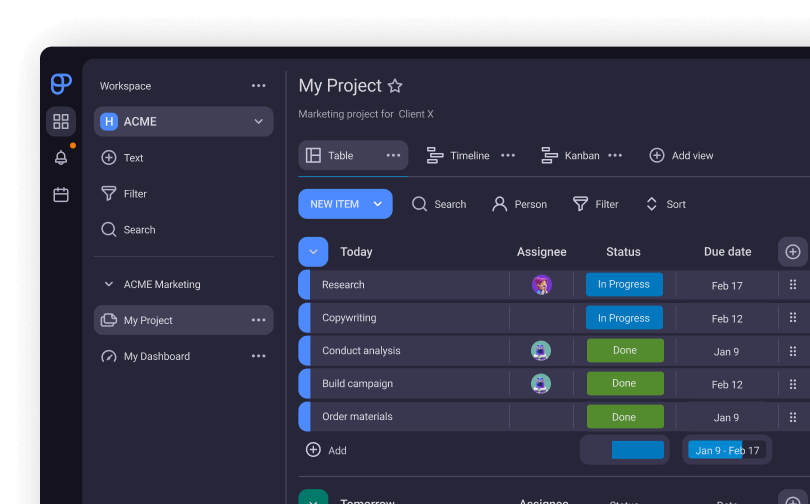What is Kanban Project Management?
Among a great variety of project management methodologies and frameworks, Kanban stands out as one of the simplest and most beginner-friendly choices that’s still capable of delivering great results.
First developed around the mid-20th century by Taiichi Ohno to improve inventory management at Toyota, Kanban has since been adapted as a virtual system for knowledge work by David J Anderson.
Kanban is suited to all kinds of knowledge work including software development, healthcare, video game development, creative writing, etc.
In this guide, we’ll cover everything you need to know about Kanban, including:
- A step-by-step guide to using Kanban,
- The 6 rules of Kanban,
- The 4 principles of Kanban,
- The benefits and drawbacks of using Kanban,
- The differences between Kanban and other Agile frameworks, and
- Important Kanban terminology.

Table of Contents
What is the Kanban process?
Although you can often come across the expression “Kanban methodology”, Kanban is actually an Agile framework — not a methodology. Aside from being Agile, Kanban also adheres to the principles of Lead project management.
At its simplest, the Kanban framework is the process of visualizing the workflow using a signboard and cards. The placement of cards on the board indicates the progress status of project activities i.e. tasks (To do, In progress, or Done).
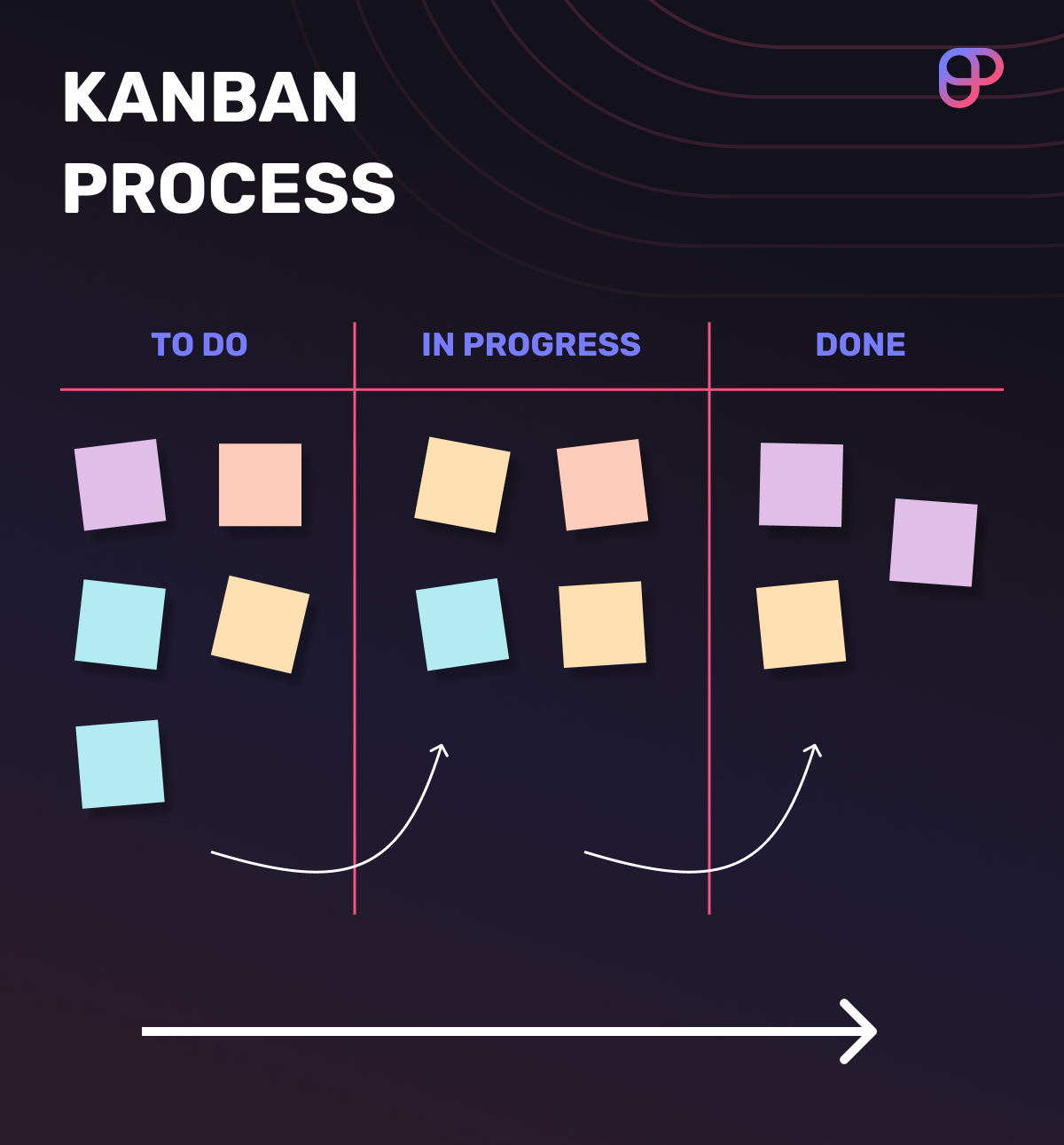
This is, of course, an oversimplification. However, we can’t go into more detail without first establishing some context surrounding the development of Kanban.
This is because the Kanban framework used today slightly differs from its Toyota roots. Explaining the old system will help you understand it as it is today.
Who invented Kanban?
Back in the 1940s, Toyota had a problem of keeping too much inventory.
As he explains in the book Toyota Production System: Beyond Large-Scale Production, Taiichi Ohno noticed that supermarkets used a so-called pull system that allowed them to keep just enough stock to meet demand.
Supermarkets track the consumption of goods via the cash register. Through the cash register, the purchasing department has insight into the selection and quantity of goods purchased, and it uses this information to restock said goods.
So, taking this as inspiration, he pioneered the Kanban method using a physical signboard. Fun fact: in Japanese, the word kanban (看板) literally means signboard.
So, he used this signboard and affixed cards to it that specified the materials needed for production on any particular piece of equipment. This way, Taiichi was successfully able to prevent overproduction and excessive transportation, among other things.
Workers would request parts needed by specifying them on the cards and sticking them to the Kanban board. These parts would then be pulled from inventory and serve as a signal for what to restock.
What’s a Kanban board?
A Kanban board is a project management tool used to visually represent the project workflow. It consists of Kanban cards arranged into columns, where each card represents one task.
Originally, this was a physical board with sticky notes attached to it. But today, with so many teams working remotely, a virtual board is used more often. You can use a task management tool like Plaky to create a Kanban board for your business.
The advantage of a virtual Kanban board is that you can fit more information into a card than you could on a literal sticky note. Kanban cards in Plaky contain information such as due date, assignee, priority, and more.
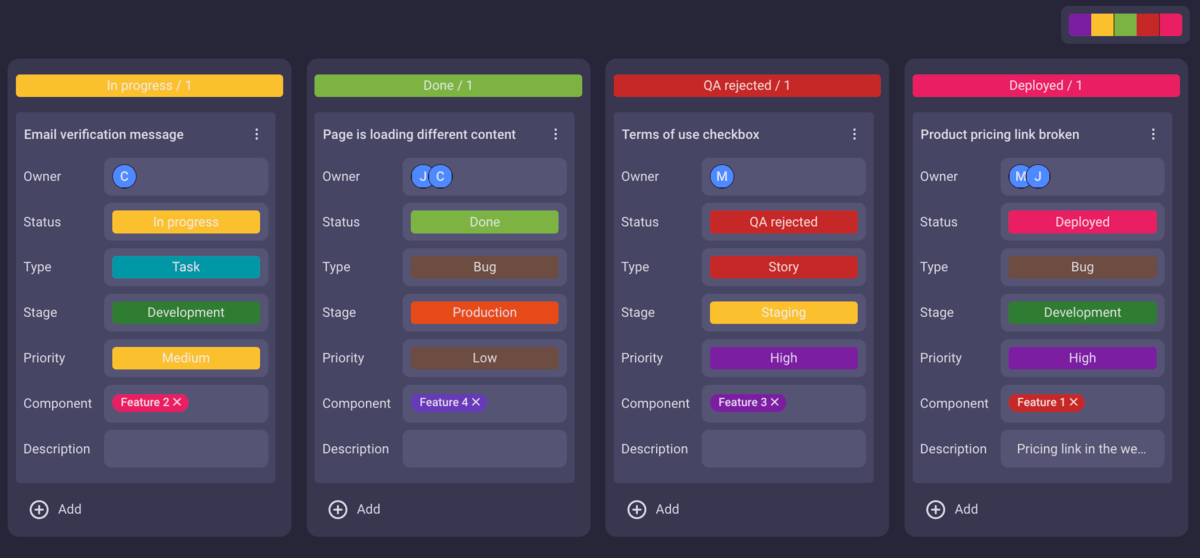
💡 Plaky Pro Tip
Kanban boards are one of the most popular tools used in project management. Check out some other handy project management techniques in the link below:
How to use a Kanban board for project management — Kanban example
It should be clear by now that managing a project in Kanban is a fairly simple process.
Nevertheless, let’s go through a step-by-step guide using the Kanban board in Plaky:
- Create a project/board,
- Add fields,
- Create tasks, and
- Optimize the workflow.
Step #1: Create a project/board
In Plaky, you can create a board by clicking on the + Add icon right below the name of your space in the upper left corner of the screen.
By default, the new board will be presented in Table View, but clicking Create new view and then Kanban will automatically create a Kanban board view.
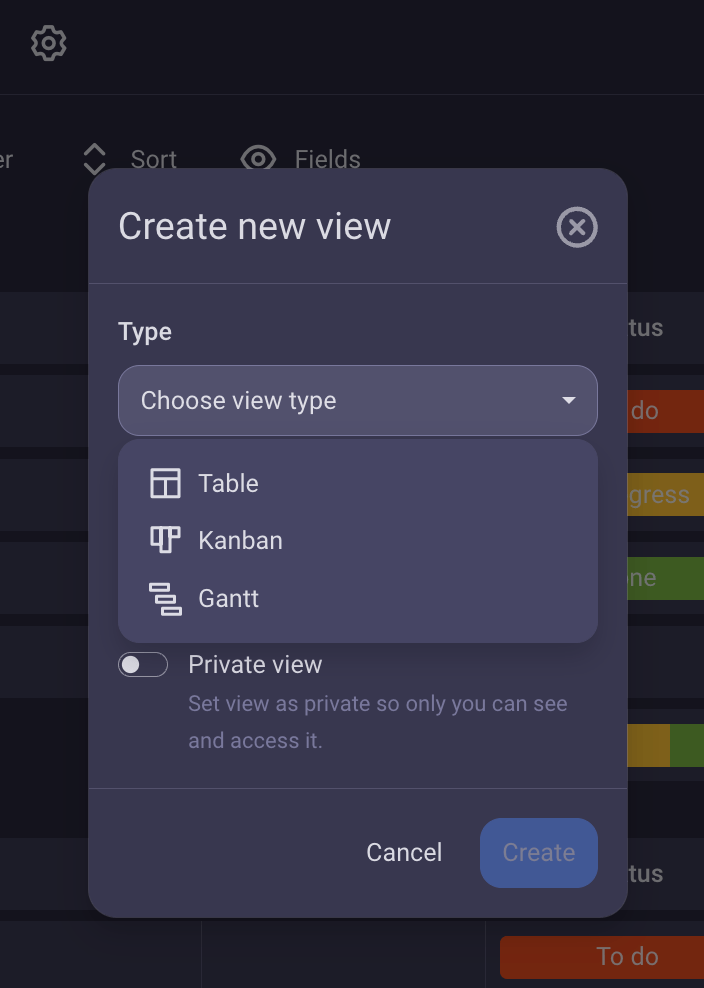
Keep in mind that this last step will not create a new board, but rather just a new way to visually organize an existing one. You can then switch between the Table view and the Kanban view on the fly.
You can create a new board for each team in the company. For example, a software development team can have their own board where they can find all their projects and tasks.
Step #2: Add fields
If you switch to Kanban view immediately upon creating a new board, the Kanban board will be empty.
The first step then is to customize it with fields.
To create fields, click on the plus icon right of the rightmost field descriptor.
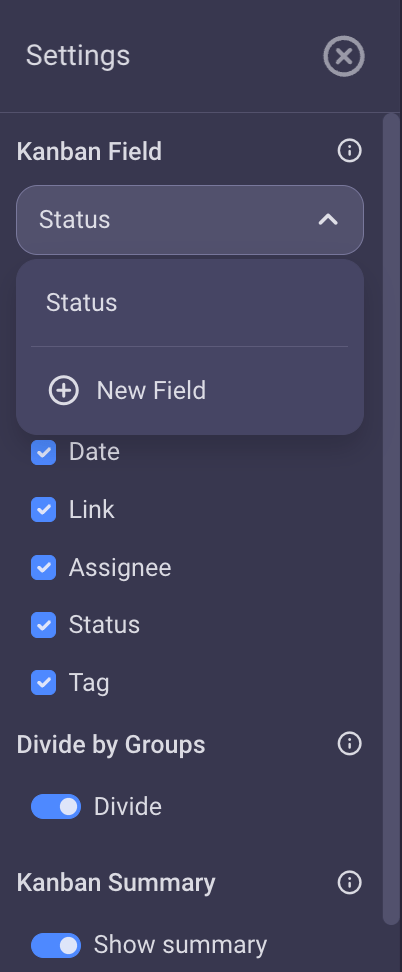
If you wish to create a wholly separate Kanban board, you can do this by pressing the Create New Group button below the lowest-positioned Kanban board.
So, if a software development team has a project with the goal to update their current app, they can create a separate Kanban board just for that.
The simplest Kanban board has 3 columns:
- To do
- In progress
- Done
Always remember that Kanban is supposed to adjust to your workflow, not the other way around. The key to success lies in customizing the Kanban board to fit the needs of your team.
Not all Kanban boards have to have the same number of columns. A 2022 State of Kanban report shows that only 21% of Kanban users rely on the simplest Kanban board, while 42% use a board with multiple columns.
For example, you can add a Backlog column before To do, or a Review column between In progress and Done. Developers working on an update of an app could create columns such as:
- Backlog,
- To do,
- In progress,
- QA,
- Ready for deployment, and
- Deployed.
Moreover, the tasks don’t necessarily have to move to the adjacent column to the right. If there is a need for it, your workflow procedure can support column skipping. Just make sure the whole team knows how they are supposed to move the task cards around.
💡 Plaky Pro Tip
Discover how workflow management software can help you manage your business:
Step #3: Create tasks
When creating tasks in Kanban, it’s best to keep them simple and on-point.
So, for example, developers shouldn’t create a task that says ‘update the app’ — that’s too broad and doesn’t specify what exactly needs to be done. Instead, they should create a separate task for each aspect of this update, such as bug fixes, 2-factor authentication, new export data feature, etc.
While you can assign multiple users to a single task in Plaky, Kanban — as a framework — favors individual work. This means one person per card at a time. You can hand off cards to other people — such as when a developer passes the card to a tester or a writer passes it off to an editor — but only one person should actively work on it at a time.
In Plaky, you create task cards by clicking on the Add button at the bottom of a column. Each task can have an assignee, due date, reviewer, priority tag, and any label or tag you want.
You can also add files and comments to the task which allows you to keep all task-related information in one place. This is what sets a board created in a Kanban project management software apart from a physical Kanban board.
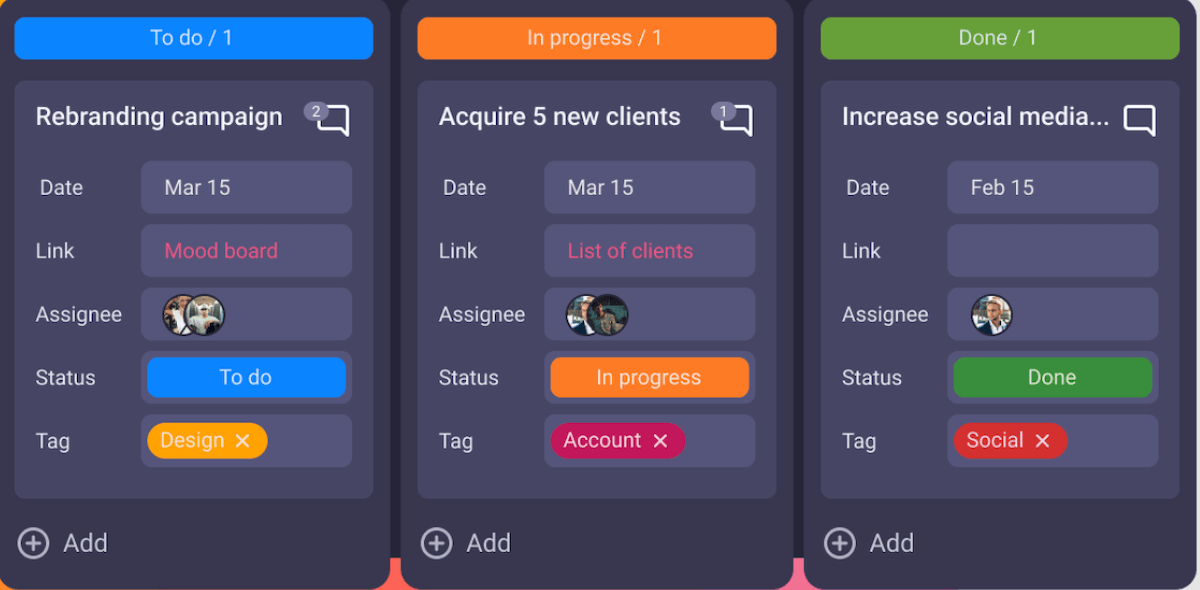
The team leader should ensure that higher-priority tasks find their way to the top of the To do column.
Alternatively — and especially if the team using the Kanban board is large — you can use the To do column as a backlog and create a Priority tasks column for priority tasks.
The project manager or team leader would populate the Priority tasks column and team members would only use this column to pull cards.
Step #4: Optimize the workflow
This last step — workflow optimization — is what separates the effective use of Kanban from just fiddling with a Kanban board.
Check to see if there are any bottlenecks in the workflow using acquired data on lead time (time between a task being made and it being completed) and throughput (the number of completed tasks in a given time).
Plaky helps with this by letting you add dates to task cards so that you can analyze them whenever you feel like it.
Take a time period — a week, a month, a quarter, whatever works for you — and work out the average lead time and throughput for that time period.
The next time you look for bottlenecks, go back the same length of time and compare the results.
This will only show you if there is a bottleneck or not.
To find out where the bottleneck occurs, you’ll have to do a bit more digging through individual cards and look for commonalities.
For example, a common cause of bottlenecks is the lack of skill diversification in a team.
If the team has only one person testing all the new features for the update, that person will surely be overwhelmed with work, and become the bottleneck in the software development workflow.
Hiring more team members who can perform that job or training existing team members to do parts of it have shown to be effective solutions to this problem.
💡 Plaky Pro Tip
Find out how to use Kanban to identify and resolve project bottlenecks:
What are the 6 rules of Kanban?
If you’ve done any digging on Kanban, you’ll likely have stumbled on the 6 rules of Kanban.
This refers to Toyota’s 6 rules of using Kanban and therefore doesn’t translate fully into the Agile project management framework. Still, these rules set the foundations for the modern use of Kanban in Agile, so we will provide you with the essence of what they stand for.
Toyota’s 6 rules are the following:
- “Never pass on defective products”
- “Take only what is needed”
- “Produce the exact quantity required”
- “Level the production”
- “Fine-tune production”
- “Stabilize and rationalize the process”
Rule #1: Never pass on defective products
Sending defective products down the line only brings additional expenses in the form of more resources spent, more working hours, etc.
Rule #2: Take only what is needed
You should only take what you need from the previous stage and start working on a new task after you finish the previous one.
This rule helps prevent overproduction and bottlenecks.
Rule #3: Produce the exact quantity required
This rule is closely connected to rule #2. The idea is to prevent overproduction and only produce what is needed.
If you produce more than required, you have to store those products somewhere, which brings additional costs. Moreover, there is a chance of that product losing its value over time.
We spoke to Leigh Ann Gunther, Director of Agile at Project Management Institute (PMI)’s Delaware Valley Chapter on the topic of Kanban. She explains how Kanban helps you produce only what is needed:

“Kanban is based on a pull model, meaning the team “pulls” work through its queue and produces what is needed to deliver value to the customer. “Pull” is a Lean practice that is based on customer input requiring continuous communication and refinement.”
💡 Plaky Pro Tip
If you are interested in learning more about Lean project management, check out the link below:
Rule #4: Level the production
This rule ensures steady and constant production. You should organize your production around the lowest-producing contributor.
This means, for example, that if a machine in a ketchup factory can fill 300 bottles with ketchup in an hour, but another machine can put a lid on only 270 at the same time, then you should reduce the number of filled bottles to 270. This way, bottlenecks are avoided.
Rule #5: Fine-tune production
After you’ve introduced Kanban into your production process, you should optimize it to ensure it’s as efficient as possible. You can assess your work by checking Kanban metrics such as lead time, cycle time, and throughput.
Rule #6: Stabilize and rationalize the process
Lastly, if you’ve followed all the previous rules, you’ll be able to stabilize your processes. This is important because it makes your processes predictable and consistent, which means team members know what to expect.
Stabilization will in turn lead to standardization, which is paramount, since, as Ohno says: “Where there is no standard, there can be no improvement”.
What are the 4 principles of Kanban?
To reap the full benefits of Kanban project management and make it more than mere signboard visualization, you should keep these 4 principles in mind:
- Respect current roles
- Make incremental changes
- Limit WIP
- Visualize workflow
Principle #1: Respect current roles
Switching to a new project management framework generally comes with a fair amount of team role, management, and organizational changes.
Most project management frameworks (to some degree) ask you to stop doing what you have been doing and make changes to accommodate it.
Scrum, for example, dictates assigning the roles of Product Owner and Scrum Master, which teams likely didn’t have prior to adopting Scrum.
Kanban is different.
Kanban asks you to respect the current roles.
In other words, adopting Kanban requires the least amount of upfront organizational change.
The idea is to keep doing what you’ve been doing, making only the necessary changes, and then to see how you can improve the workflow over time using this framework.
This not only makes Kanban easy to implement, but it also makes teams less resistant to it and doesn’t slow down the workflow as there’s no need for a lengthy adjustment period.
Principle #2: Make incremental changes
In keeping with the previous guiding principle, Kanban is all about making small but meaningful changes.
The idea isn’t to impose seemingly arbitrary rules and regulations upon your team.
Instead, by using Kanban and adhering to the principles outlined here, your team will naturally find ways to streamline and improve the workflow by making small changes.
The only major change that Kanban demands from you (and which you can still ignore, to your detriment) is getting rid of multitasking by implementing work-in-progress limitations.
Principle #3: Limit WIP
Studies have shown that multitasking doesn’t work.
What may seem like a workflow maximizing practice — juggling 2 or more tasks at once — is, in fact, counterproductive to a fault.
Kanban combats multitasking by imposing WIP (work-in-progress) limits.
In practice, this works by limiting the number of active tasks each team member is allowed to drag into the In progress column.
This is typically the first incremental change Kanban brings to teams using it and one that’s proven to heighten performance.
Leigh Ann emphasizes the importance of WIP limits:

“The most significant advantage of using Kanban is the principles of WIP (work-in-process) limits. When using Kanban boards, you can visualize work delivery and workflow across multiple teams, which helps break up even the most complex projects and initiatives by managing the work done by each team or team member. By limiting the amount of work that can pile up on one person’s or team’s plate, you can identify bottlenecks and manage your overall throughput – thereby improving overall team speed.”
Principle #4: Visualize workflow
The importance of workflow visualization for Kanban cannot be overstated.
The framework is named after its namesake signboard for a reason.
Teams can customize their Kanban boards to their needs. In essence, Kanban is all about taking limited WIP and workflow visualization and customizing it to fit your needs.
In Plaky, you can fully customize your Kanban board to fit your liking, including setting any number of columns and creating any number of boards.
For example, a software development team has their board, HR has a separate board, sales has a separate board — same with customer service, marketing, and so on.
Benefits of using Kanban for project management
Introducing Kanban into your business process will surely have a positive impact. In the 2022 State of Kanban report, 50% of the participants claimed that Kanban was “more effective” than other frameworks, while 37% said it was “much more effective”.
Among the many benefits of implementing Kanban into your organization, we are going to name just a few:
- Increased efficiency,
- Transparency, and
- Improved collaboration
Benefit #1: Increased efficiency
With WIP limits in place, each team member has just the amount of tasks they can handle at any given time, which allows them to focus exclusively on these tasks and be more efficient.
Since no more tasks can be added to the Doing column until they finish one, tasks don’t pile up, and bottlenecks are avoided.
Benefit #2: Transparency
The Kanban board is an excellent visual tool that allows project managers and team members to see who is working on which task, and in which stage they are. The entire workflow is transparent, and you can see where your work fits into the workflow.
This ensures that no one is overworked or underworked and prevents team leaders from unknowingly assigning too many tasks to one person.
Benefit #3: Improved collaboration
A task can easily move from one person to another. Let’s take implementing a new feature from a software development project as an example.
An engineer works on development and, upon finishing their part, transfers the card to the testing column, where a tester takes over.
David J Anderson School of Management’s research on the benefits of Kanban states that when Kanban was introduced to teams at the US Department of Labor to improve performance and collaboration, lead time was reduced by 90% for non-technical teams and 80% for technical teams.
Drawbacks of using Kanban for project management
While Kanban is a great technique for project management, it isn’t perfect. Here are some of its main drawbacks:
- Not suitable for iterative projects,
- Not appropriate for dynamic workflows, and
- No timeframe.
Drawback #1: Not suitable for iterative projects
Kanban was created with a sequential workflow in mind — tasks move from the To do column, across however many columns you need, to the Done column. Although it’s possible to move tasks back and forth, it’s not practical.
So, this isn’t an ideal framework for projects where tasks circulate and go through some stages several times.
Drawback #2: Not appropriate for dynamic workflows
As the second principle states, Kanban embraces small and incremental changes. This is why it isn’t suited for dynamic projects where changes occur often and you have to constantly adapt to them.
Drawback #3: No timeframe
Kanban tasks don’t have a strictly determined timeframe. This means that there’s no way of knowing when a task will move from To do column to In progress, or from In progress to Review column.
Although tasks in Plaky have due dates, this only represents the final point when a task must be done, and it won’t help you deduce when it might move from one column to another.
What is the difference between Kanban and Agile?
Once they understand Kanban, most people like to compare it to other approaches to see where major differences lie.
Most notably, people often compare Kanban and Agile. Agile is a well-known approach formally established in 2001 thanks to the Agile Manifesto, but it was in use much earlier than that.
Coursera defines Agile as “an approach to project management that centers around incremental and iterative steps to completing projects”.
However, comparing Kanban and Agile is a bit like comparing apples and apple trees, since Kanban is merely a framework for Agile.
Nevertheless, Kanban does take some departures from Agiles that other frameworks don’t.
The main differences between Kanban and Agile are:
- Kanban isn’t iterative by nature — While Agile generally favors iterative development, Kanban leans towards continuous development.
- Agile doesn’t impose WIP limitations — While the drawbacks of multitasking have been extensively studied and are well-known, Agile doesn’t impose WIP limitations. It doesn’t argue in favor of multitasking either, but the idea of limiting WIP is all Kanban.
💡 Plaky Pro Tip
If you want to learn more about Agile, make sure to read our guide:
What is the difference between Kanban and Scrum?
Comparing Kanban and Scrum is a much more reasonable endeavor, as these are both popular Agile frameworks.
In other words, both Kanban and Scrum serve to make you Agile, but they do so in completely different ways.
The main differences between the 2 are that Scrum:
- Is more prescriptive,
- Uses dedicated roles (Product Owner, Scrum Master, Developers),
- Organizes work in Sprints, and
- Has obligatory meetings during the Sprint.
Leigh Ann contrasts these two approaches and highlights some differences and similarities between Kanban and Scrum:

“For starters, there are a few administrative differences, such as how a Scrum Master leads a Scrum team versus how an agile coach leads a Kanban team. Both Scrum Masters and agile coaches instill best agile practices and keep their teams moving by removing barriers. Most notably, Scrum pulls work from a Product Backlog into a Sprint Backlog, and the user stories are planned, committed, and delivered within predefined timeboxes called “Sprints.” Based on the highest priority and WIP limits, Kanban boards continuously pull user stories from one Product Backlog”
Despite the differences, Scrum and Kanban are not mutually exclusive. The aforementioned State of Kanban report showed that 57% of those who implemented Kanban were already using Scrum at the time.
There is even a Scrumban framework — a combination of the 2 Agile frameworks.
Besides, as Leigh Ann points out — no approach is better than the other. It all depends on the situation:
“When choosing between Scrum, Kanban, or a hybrid approach, you must take into consideration the team structure and the details of the project at hand.”
💡 Plaky Pro Tip
Like Kanban, Scrum is a framework with a fair bit of technical terminology. If you want to learn more about Sprints and roles in Scrum, we suggest reading this guide:
Conclusion: Kanban is a great way to dip your toes into project management
Kanban is not only one of the most popular project management frameworks, but it’s also one of the simplest and most easy to use.
By limiting work-in-progress and measuring workflow, Kanban becomes a great diagnostic tool for working out the bottlenecks in your workflow and improving overall performance.
Project management gets a lot easier when you’re using the right software, especially if your workflow utilizes a pull system that requires visual clarity and transparency. Sign up for Plaky’s free account today and start managing your projects with Kanban.
Basic Kanban terminology
- Kanban board — signboard (physical or virtual) to which you add cards and move them around to signal workflow.
- Kanban card — a form (analogous to a sticky note) that carries information relevant to the task (name, assignee, due date, etc.). Sometimes, the term task is used instead of card.
- WIP limitations — WIP is an acronym for work-in-progress. WIP limitation is one of the guiding principles of Kanban — the idea being that avoiding multitasking by limiting the number of cards individuals can drag into the In progress column at the same time is greatly beneficial.
- Throughput — used to quantify the number of completed tasks in a given time. This may sound redundant, but it’s worth pointing out that tasks that are still in progress don’t count towards throughput, only ones that are completed.
- Lead time — the time that passes between a task being made (not the moment you start working on it) and it being completed. Low lead time translates to good customer satisfaction.
- Cycle time — measures how long it takes to complete a task from the moment work on it begins. Low cycle time indicates good workflow.
- Bottlenecks — the main indicators of things going wrong in Kanban. Strong indicators of bottlenecks include longer cycle times and/or lower throughput. Bottlenecks can also be discerned through cumulative flow diagrams.
- Cumulative flow diagrams — a useful tool with roots in queuing theory that can provide valuable insight into the efficiency of your Kanban practices. While nothing that can’t be worked out simply by using the data from accrued cycle times and throughput, cumulative flow diagrams provide a visual insight that allows you to spot bottlenecks more easily.
📖 If you’re interested in learning more about project management and like your information presented in a comprehensive and easy-to-understand manner, check out our Project Management Glossary of Terms.
References
- Anderson, D. J. (n.d.). A Brief History of Kanban for Knowledge Work. Retrieved March 28, 2022, from https://djaa.com/brief-history-kanban-knowledge-work/
- Beck, K., Beedle M., & van Bennekum, A. (2001). Manifesto for Agile software development. Retrieved June 5, 2023, from https://agilemanifesto.org/
- David J Anderson School of Management. Explore the benefits of Kanban. https://djaa.com/wp-content/uploads/2021/06/Benefits-of-Kanban-3.pdf
- Indeed Editorial Team. (2022, November 9). What Is the Kanban System and How Does It Work? (6 rules). Indeed. Retrieved May 30, 2023, from https://sg.indeed.com/career-advice/career-development/kanban-system
- Kanban University. (2022). 2022 State of Kanban Report. https://kanban.university/wp-content/uploads/2022/10/State-of-Kanban-Report-2022.pdf
- Ohno, T. (1978). Toyota Production System: Beyond Large-Scale Production. Productivity Press
- Roser, C. (2020, August 25). Toyota’s Six Rules for Kanban. All About Lean. Retrieved May 30, 2023, from https://www.allaboutlean.com/toyotas-six-rules/
- Toyota Blog. (2013, May 31). Kanban – Toyota Production System guide. https://mag.toyota.co.uk/kanban-toyota-production-system/.
- What Is Agile? And When to Use It. (2023, May 17). Coursera. Retrieved June 7, 2023, from https://www.coursera.org/articles/what-is-agile-a-beginners-guide
- Why multitasking doesn’t work. (2021, March 10). Cleveland Clinic. Retrieved June 6, 2023, from https://health.clevelandclinic.org/science-clear-multitasking-doesnt-work/
 Project Management Hub
Project Management Hub 

